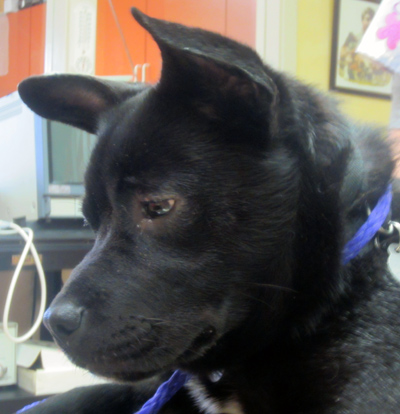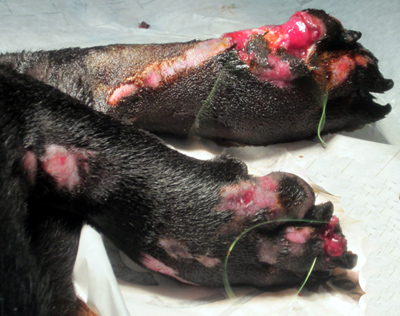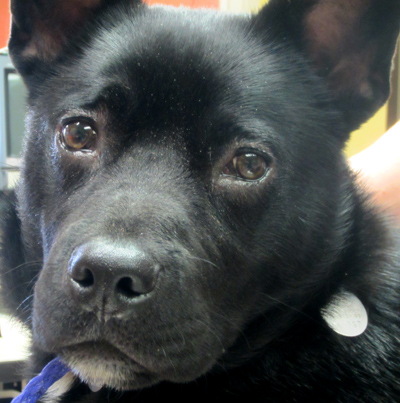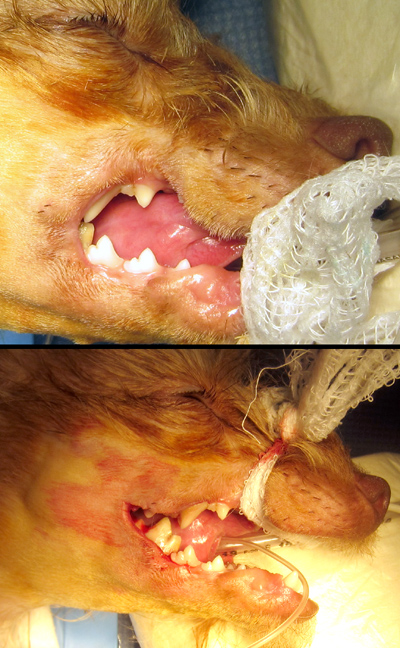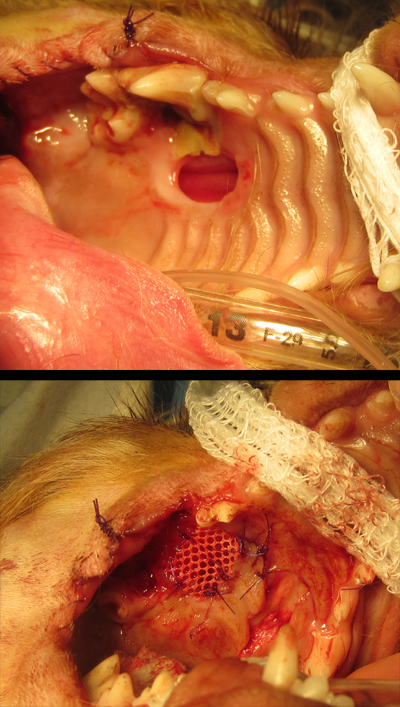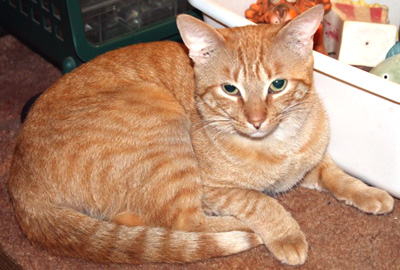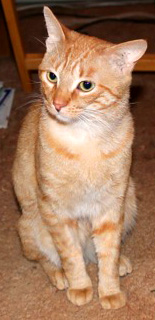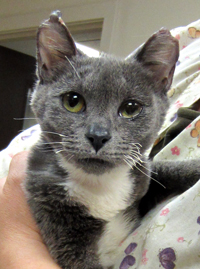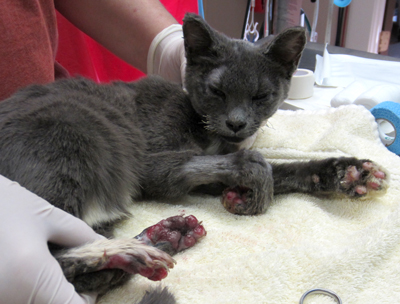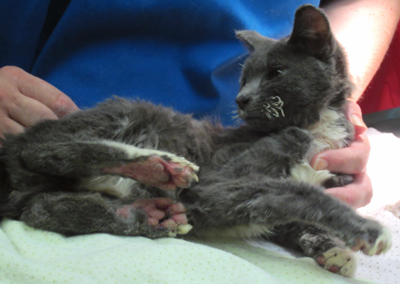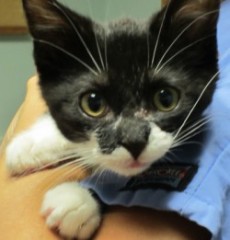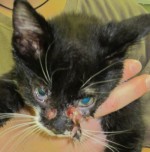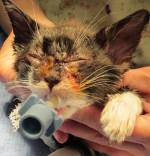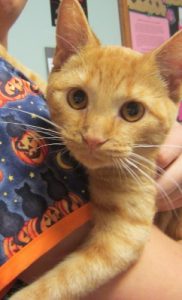
Ginger
December 2017
Ginger the Stray 
When Ginger’s family first found her as a stray kitten, they thought that all she would need to get back on her feet was a little TLC in her new home- one that they were happy to give her. She got settled in and it seemed like everything was going smoothly as she adjusted to her new life. Soon enough, she would charm her way into their hearts and make herself a part of their family.
Things seemed to be going smoothly for the lucky kitten at first. And then came the morning where she started vomiting every time that she ate. Even worse, there was blood in her vomit. Fearing the worst, Ginger’s family rushed her to the Dunkirk Animal Clinic, hoping Dr. Frost could figure out what was happening to the newest member of their family.
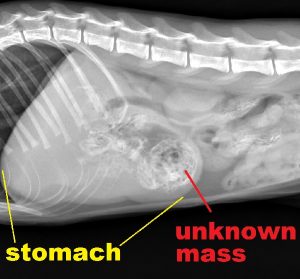 When Dr. Frost was looking her over, she felt her stomach, trying to see if she could feel something that might be causing the issue. She felt something abnormal and it was quickly decided that they needed an x-ray to help figure out what exactly was in her stomach. The x-ray showed many foreign objects in her stomach and intestines that she needed to have removed to give her the best chance at recovery.
When Dr. Frost was looking her over, she felt her stomach, trying to see if she could feel something that might be causing the issue. She felt something abnormal and it was quickly decided that they needed an x-ray to help figure out what exactly was in her stomach. The x-ray showed many foreign objects in her stomach and intestines that she needed to have removed to give her the best chance at recovery.
Her owners gave the okay and that afternoon, Ginger was rushed into surgery. She had eaten a handful of small plastic casings while she was a stray on the streets. When the casings moved through her system they created the blockage that made her start vomiting.
It took a few days in the hospital for Ginger to be well enough to get to go home, but since she has she’s been as healthy as ever and made a complete recovery. Now she gets to spend her days enjoying her new lease on life.
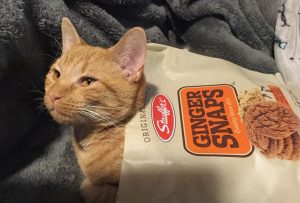 *Ginger was our grand prize winner for the Halloween Pet Costume Contest of 2017.  She was dress up as Ginger Snaps!
*Ginger was our grand prize winner for the Halloween Pet Costume Contest of 2017.  She was dress up as Ginger Snaps!
July 2012
Above and Beyond:  Kudos to our Local Good Samaritans
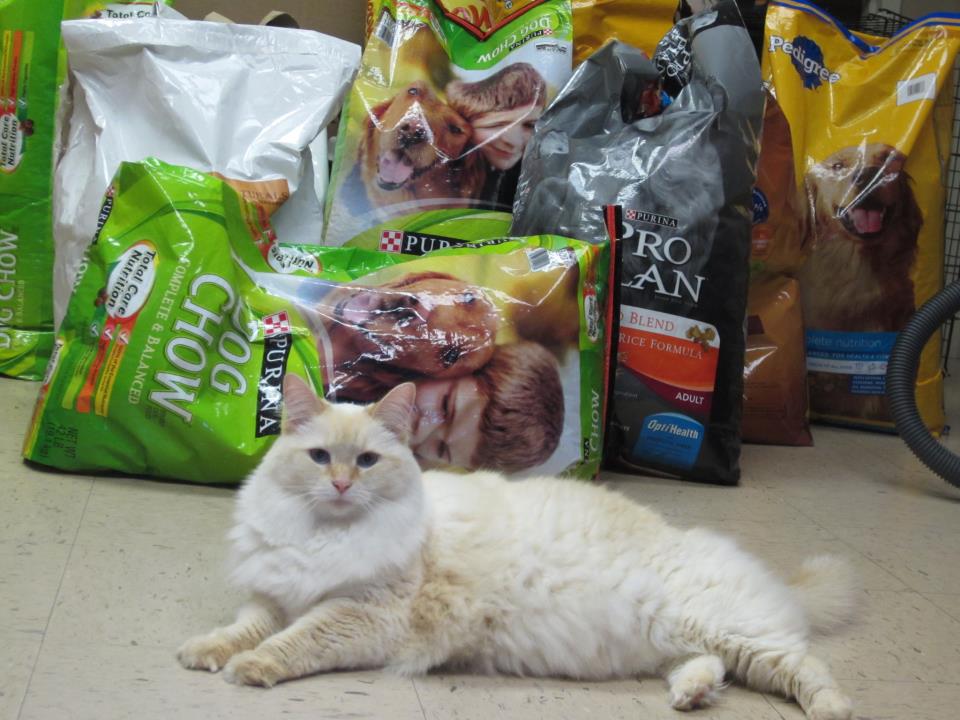 If you work in the field of veterinary medicine long enough, chances are you will handle a few cases that stick with you for life. The same can be said of people, and here at the Dunkirk Animal Clinic we are truly blessed to have so many kind souls involved with our practice. This month we have dedicated to those clients and members of the community who go above and beyond for animals in need. Whether it is the Lakeshore Humane Society, The Pet Pantry, or any of our especially dedicated clients*, it is wonderful to know that there are such caring individuals out there. Often putting the animal’s needs ahead of their own, these people care deeply not only for their own pets, but for many other homeless and neglected animals. Giving generously of their money, their time and often space in their own homes, we can not thank them enough for all they do to help out the local stray population. Simply getting them in for a check up and vaccines, or even paying for them to be spayed or neutered in some cases, there is no effort too small that isn’t appreciated. (After all, it is only with human intervention that we can begin to address the rampant overpopulation of stray pets.) With that, we want to recognize all of the hard and often heart wrenching work these people do and how much they contribute to making what we do as veterinary professionals a real pleasure. Thank you for all you do!!
If you work in the field of veterinary medicine long enough, chances are you will handle a few cases that stick with you for life. The same can be said of people, and here at the Dunkirk Animal Clinic we are truly blessed to have so many kind souls involved with our practice. This month we have dedicated to those clients and members of the community who go above and beyond for animals in need. Whether it is the Lakeshore Humane Society, The Pet Pantry, or any of our especially dedicated clients*, it is wonderful to know that there are such caring individuals out there. Often putting the animal’s needs ahead of their own, these people care deeply not only for their own pets, but for many other homeless and neglected animals. Giving generously of their money, their time and often space in their own homes, we can not thank them enough for all they do to help out the local stray population. Simply getting them in for a check up and vaccines, or even paying for them to be spayed or neutered in some cases, there is no effort too small that isn’t appreciated. (After all, it is only with human intervention that we can begin to address the rampant overpopulation of stray pets.) With that, we want to recognize all of the hard and often heart wrenching work these people do and how much they contribute to making what we do as veterinary professionals a real pleasure. Thank you for all you do!!
*We would LOVE to recognize each and every one of you, but for the sake of your privacy we are not giving names. (But you know who you are!) J*

Willie
May 2012
Heartworm “Willie”
One of the happiest patients we have seen here at the clinic, Willie came to us in early May for his annual vaccinations and Heartworm test.  An exuberant but gentle fellow, Willie was a nine-year-old chocolate lab who had recently been adopted from a rescue in Ohio.  The couple that adopted him had wanted an older dog and were generally prepared to deal with any age related issues, however when a routine Heartworm test came back positive, it was a little more than they had bargained for.  It also raised a lot of questions.  What exactly was heartworm?  What were the symptoms and how did he get it?  Could it be treated?  Better yet prevented?  Read on to find out!
Heartworm disease is transmitted by an organism called Dirofilaria immitis and is carried by the common mosquito.  Animals (primarily dogs or other canids) are infected after being bitten by a mosquito carrying the disease.  Once the organism is ‘injected’ into the host animal via the mosquito’s proboscis (mouth parts), it circulates throughout the blood and ultimately ends up in the heart where it matures into adult worms.  These adults can reach up to 12 inches in length and if left untreated, can multiply and cause serious heart and lung damage to your pet.
While seen in ALL fifty states, heartworm is most prevalent in tropical and subtropical zones, especially along the Atlantic and Gulf coasts and in the Ohio/Mississippi river basins. In endemic areas, virtually 100% of unprotected dogs are infected with heartworm.  (It is a good idea to be aware of this when either adopting or transporting dogs from out of state.)  Male dogs are more likely affected than females and the highest incidence of infection is in dogs between 3 and 8 years of age.
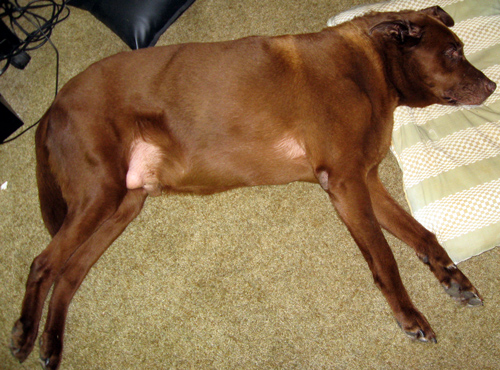
I’m tired!
Signs of heartworm disease are varied and often resemble other conditions.  Unfortunately, by the time signs become apparent the disease can be fairly progressed.  (This is why it is a good idea for yearly heartworm testing because the disease can be caught and treated in its earlier stages.)  In early stages of the disease, dogs are either asymptomatic (show no signs) or might have an occasional cough.  As the disease progresses, animals might experience more frequent coughing and become intolerant to exercise. There might also be some initial lung damage.  If the disease is left untreated, animals might cease to eat, become anemic, have fainting episodes and ultimately end up in heart failure.
The good news about heartworm disease is that it IS preventable and there are very accurate and easy tests available for detection.  Most tests in fact require only a very small amount of blood and give results in less than ten minutes.  After a clean bill of health (including a negative test result), there are several prevention options.  One is a chewable tablet that is given once monthly.  The other is a topical application that is a combination flea and heartworm preventative.  This is a fairly popular option and in many cases, also helps to control intestinal parasites.
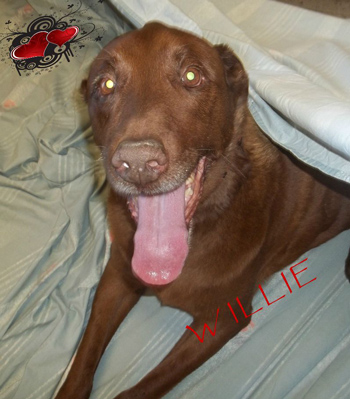
Willie’s lov’in life!
Regarding our friend Willie, it was lucky for him that we caught the disease during early onset as he had a much better chance of being treated without complications.  Treatment for Willie and other heartworm patients entails a series of two heavy-duty injections deep into the muscles of the back.  Each injection consists of very strong immiticide (worm killer) and is given 24 hours apart.  Following treatment, the patient’s activity level should be restricted for at least several weeks. This is because as the medication takes effect and adult worms start to die off, they ‘drift’ into the lungs (following the natural flow of blood through the body) and can potentially cause a pulmonary embolism (blood clot in the lungs) – especially if there are a lot of worms as in later stages of the disease.  If treated early, there will be fewer adult worms and much less risk to the patient.
After a successful round of treatment, Willie was sent home the following day where he continued to recover with plenty of TLC from his loving owners.  Several months later, Willie continues to do well at home.  He loves his naps (who doesn’t? J), but he also still has his frisky moments where he is as young at heart as ever!
April 2012
“Lancer” with the Lakeshore Humane Society (LSHS)
‘Lancer’ first came to us by way of an animal control officer who received a call from the Dunkirk Police about a small black dog who had been hit by a car. On the scene, the officer found a very friendly, happy dog who despite having substantial injuries to both hind paws was still ‘smiling’ and wagging his tail. The officer was immediately taken with the dog and knew that with a little hospital care and a good foster home during recovery, he would make someone an excellent companion.
After evaluation at the clinic, Dr. Frost proceeded to give Lancer several injections for pain relief, sedation (so the wounds could be cleaned and cared for without undue stress or anxiety), and antibiotics to prevent infection. While miraculously there were no broken bones, much of the skin on both hind paws had been ripped off or was hanging as a loose flap around the foot. In such cases, if the wound is several days old or if the tissue is starting to necrose (die), living tissue from another area may be used as a skin graft over the wounded area. With Lancer however, the wound was fresh and had a good blood supply so Dr. Frost was able to use the surrounding tissue for reconstruction.
Several sutures and a good bandaging later, Lancer was sent home with his new Lakeshore Humane Society foster mom. Here he could heal, finish his medications and become adjusted to life in a home. Within the first day that Lancer spent at the clinic, it quickly became obvious what a special little guy he was – VERY easy going, relaxed and happy as can be. He loved people and was very friendly with everyone he met, even though most of us were fussing with his feet (which had to cause some amount of pain)!
Over the next few weeks we saw Lancer quite often and what a joy! Each time, his paws looked better and he continued to grow into his own personality. He was a relaxed dog and a model patient. Once his paws had healed sufficiently, it was time to be neutered! After his operation, he went to a new foster home where he had another dog to play with. He and the other dog hit it off immediately, which was good news in terms of his adoptability. Being friendly not only with people, but with cats AND dogs made his chances of finding a good home that much better.
As Lancer continued to thrive in his foster home, the LSHS and members of our staff advocated to all who would listen what a great dog he was and what an excellent companion he would make. After a few weeks, we had some interest! One of our clients had recently lost their dog of many years and were considering a new family pet. Hearing about Lancer and what he had been through, they decided to go ahead and meet him. What could it hurt? As it turned out, the encounter was a huge success and when Lancer cuddled his head into the would be owner’s lap, the deal was sealed. Lancer had himself a new home! As the weeks have now gone by, Lancer is doing wonderful. He is adjusting well to his new family and is a very loved (and loving) family member who thinks himself a 35-pound lap dog. Truly it is hard to say who is happier – Lancer, or his new owners.
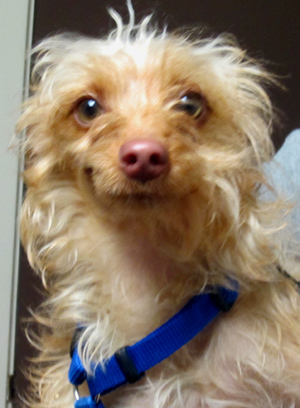
Ginger
March 2012
“Ginger” with the Lakeshore Humane Society (LSHS)
We first saw sweet Ginger (a small female terrier mix) in early January of this year when a Lakeshore Humane Society volunteer brought her in for a check up.  Little was known about her history, except she had been picked up on Christmas Eve by an animal control officer and brought to the city pound.  It was not long after, that the LSHS found her and decided to take her under their wing.  Ginger came in to the clinic for a general check up, but more specifically because her breath was atrocious and she was missing large parts of her right lip fold.  It appeared to be an older injury, at least several months old, but it was healing in such a way that the skin was fusing directly to her gums and becoming packed with debris such as hair and old food.  Because of this, she could not open her mouth all the way, which made picking up food and eating a far more difficult and awkward task.  Needless to say, her poor mouth STUNK and was probably quite painful as the wound continued to fester.
Despite her injuries however, little Ginger was about the sweetest dog you could ask for.  She was very eager to both give and receive ‘kisses’ and LOVED to be held.  She was a very gentle, HAPPY dog with a great disposition – surely she would make someone a wonderful companion!  After a full check up (she appeared to be healthy otherwise), it was determined that the best course of action would be to spay her and while under anesthesia to try and repair her lip – at least so she could open her mouth all the way and chew properly without pain.
Come the day of surgery, her spay procedure went without incidence, but when it came to reconstructing her mouth, we were in for a surprise.  Not only was there the issue with her fused lips, but she had a large nickel size hole in her hard palate (aka the roof of her mouth).  Yikes!  Dr. Frost now not only needed to reconstruct this little dog’s lips, but repair the gaping hole in the top of her mouth.  In doing so, several teeth needed to be removed and skin from another area of her mouth was grafted (along with a small piece of surgical mesh) over the hole.  Ultimately it was hoped that this new skin would begin to grow naturally and heal over the wound.
Post surgery, Ginger did very well.  Her lips healed as anticipated which gave her back full range of motion with her mouth and she was finally able to eat normally without pain.  She felt so good in fact, that a few weeks later her foster mom called, reporting that Ginger was happily teething on just about everything in her house – the couch, cell phone cords, $5 bills, and anything else she could fit in her mouth.  The inner puppy had been released!
Several weeks later, the LSHS called to let us know that dear Ginger had found herself a new forever home!  She was adopted by a nice retired couple who had become absolutely smitten with her.  The moral of the story – there are happy endings!  Found as a stray, Ginger was given a second chance through the humane society and ended up making someone a fantastic companion!  Although who is luckier, Ginger or her family, is still up for debate.
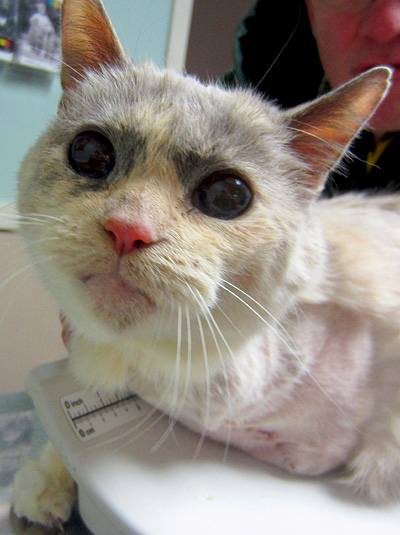 February 2012
February 2012
“Dana” McGill
Hi! My name is Dana and this is the story of how I lost my leg but gained another chance at life!  I am a lovely 11-year-old Siamese cat who loves attention and can be very vocal about everything! I was seen at the Dunkirk Animal Clinic as a second opinion regarding my obsessive licking of my left front forearm.  It began about three months prior and was treated as an allergy. I licked and chewed at the area until I had a deep ulcerated wound that went nearly to the bone. My licking was not the sole culprit of this nasty wound. It turned out there were far greater forces at work in my little arm than just my tongue.
After being seen by a doctor and reviewing my history, Dr Frost decided to take a sample of the area for biopsy and send it to a lab to get a definitive diagnosis. Cancer was unfortunately at the top of the list, but we needed to know which kind as some cancers are more likely to metastasize (spread) into other organs of the body while some are content to just keep eating away at one locale.  They also took an x-ray of my leg to see how deep the damage went and how much of the bone had been affected.  The x-rays showed that the bone was affected as well. While we were waiting for the biopsy results to come back, I came into the clinic at least every other day for a check up and bandage change.
 A week later, the lab determined that I had a type of cancer called Squamous Cell Carcinoma, a very aggressive cancer. The next step was to take an x-ray of my entire body just to make sure that the cancer had not spread anywhere else.¬† Luckily, the x-rays revealed that all of my internal organs looked normal ‚Äì there was no sign of the cancer having spread. Now it was decision time and really there was only one choice to make.¬† If my owners wanted me to live with any quality of life or even have a life at all, my entire limb would have to be amputated.¬† At first my owners were a bit hesitant ‚Äì could an older cat learn to live with and get around on only three legs?¬† Absolutely!¬†¬† Animals can adjust surprisingly well and quickly to many physical changes ‚Äì they don’t know they have anything ‚Äúthe matter‚Äù with them or that they should be ‚Äúdisabled.‚Äù¬† In any case, my owners gave the go-ahead ‚Äì my leg was coming off!
A week later, the lab determined that I had a type of cancer called Squamous Cell Carcinoma, a very aggressive cancer. The next step was to take an x-ray of my entire body just to make sure that the cancer had not spread anywhere else.¬† Luckily, the x-rays revealed that all of my internal organs looked normal ‚Äì there was no sign of the cancer having spread. Now it was decision time and really there was only one choice to make.¬† If my owners wanted me to live with any quality of life or even have a life at all, my entire limb would have to be amputated.¬† At first my owners were a bit hesitant ‚Äì could an older cat learn to live with and get around on only three legs?¬† Absolutely!¬†¬† Animals can adjust surprisingly well and quickly to many physical changes ‚Äì they don’t know they have anything ‚Äúthe matter‚Äù with them or that they should be ‚Äúdisabled.‚Äù¬† In any case, my owners gave the go-ahead ‚Äì my leg was coming off!
Everything went very smoothly with surgery and Dr Frost was pleased with how the procedure went.  At my owner’s request, I was kept in the hospital and monitored for two extra days.  They wanted to make sure that I had adequate time to recover and get adjusted to my new body. Boy did I! The first day home I had no problems getting around and I even navigated a few stairs!  My owners were thrilled.  They could tell how much better I felt and what a relief it was for me to no longer carry that cancerous burden.
Ten days later I came in for suture removal.  The incision site looked great and was healing well, but more importantly perhaps, I was a MUCH happier, healthier cat.  My quality of life had improved ten-fold and I now feel blessed to have another chance at living another wonderful 11 years.
January 2012
Three Cheers for Butterscotch
Hello, my name is Butterscotch and boy do I have a story for you!  First off, I’m a delightful 2-year-old orange tabby with a very sweet disposition.  I’m a boy of course, and extremely playful with the other animals in the house.  I especially love to antagonize the dog!  So one day in early January, I started to REALLY not feel well.  I was extremely lethargic, had no appetite and was not passing any bowel movements or urine.  My owners were concerned and brought me in to see the veterinarian.  Upon arrival, it was immediately clear that something was very wrong – I was in BAD shape.  My temperature was only 90 degrees (a full 10 degrees BELOW what a normal kitty temperature should be), and I was about 12% dehydrated – yikes!!  Most importantly, my bladder was HUGE!!  Very quickly, the doctor had his diagnosis – I was a “blocked cat.”  What this means, is that “something,” whether a small stone, a build up of crystals or residue from infection, is plugging the urethra and making it impossible to urinate.  This is an extremely painful and often fatal condition, because by the time signs become apparent, too much time has already passed.  The usual window for having any chance at saving a blocked cat is only 24-72 hours Рnot a long time.
In any case, the bladder gets bigger and bigger and when the bladder can’t hold any more, the urine starts to back up through the ureters and into the kidneys, carrying all of the urinary waste and infection with it.  If left untreated or not treated soon enough, patients will ultimately die of kidney failure.  Faced with this grim reality, my owners still opted for hospital care – if there was any possibility for me to recover, they wanted to give me that chance.  Upon admission, I was immediately given a good combination of sedatives and analgesics (aka pain killers).  They hooked me up to IV fluids, ran some initial blood panels, and gave me a good dose of antibiotics.  They also passed a urethral (urinary) catheter to relieve the pressure in my bladder and give my kidneys a chance to start functioning normally again.  Over the next three days, my hydration status and temperature improved, I developed an appetite, and I became gradually more attentive to my surroundings.  In this amount of time, I also produced 1300 ml (1.3 L) of bloody urine.  (Think about what that was doing to my poor kidneys!!)
Three days after admission, they took my urinary catheter out, started me on oral antibiotics and prescribed a medication that would help with my urethral spasms.  Even though I was no longer blocked, my bladder muscles were still very stretched out because of all the previous urine build up.  It was going to be a little while before my bladder regained its tone and was able to effectively contract to expel urine.  In the meantime, I remained at the clinic for another three days so that the doctors could manually express my bladder.  Six days after being admitted, I was released to my anxious owners.  At this point I was eating ok, my kidney values had improved and I was dribbling a little urine in the litter box.  I still couldn’t empty my bladder all the way though, so part of the discharge instructions to my owners, were to instruct them as to how they might help express my bladder at home – at least until I was clearly using the litterbox on my own. Two days after being released, the clinic called to check up on me.  My owners happily reported that I was urinating on my own and that the urine had returned to a normal yellow color (no more blood!). I was also eating well and very active Рeven ‘whooping up’ on the family dog.  Fast forward a few weeks and I am continuing to do great at home!  My owners are feeding me a special urinary health diet to help me in NOT having this issue again, but otherwise I am one happy, lucky cat!
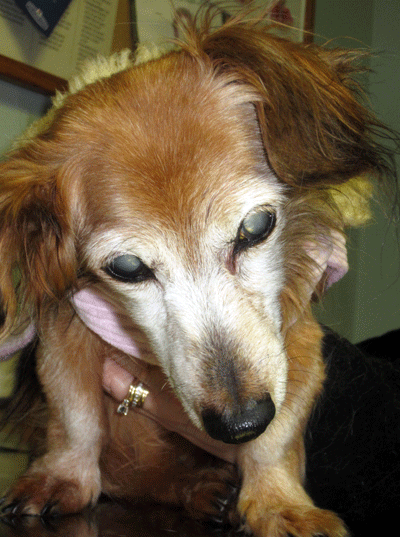 December 2011
December 2011
Sweet Sarah
It’s been over eighteen years since I was born an energetic dachshund pup! Now at the ripe old age of eighteen, I am still kicking but with a little less energy.  Except of course when it is time for me to get my toenails trimmed – then I have LOTS of spunk giving the doctors a hard time! Even though I look as old as a 100-year-old lady, my blood work still looks like it did in 1993 when I was spayed.  Impressive!
Being as old as I am, I have had some health problems:  retained deciduous (baby) teeth, vertebral disc disease (especially because of my LOOONG body and spine), allergic reactions, spinal arthritis and most especially dental disease. My teeth have always been my biggest problem РI have a history of tartar, gingivitis and periodontal infection. Over the years I have had four dental cleanings to help keep my teeth as healthy as possible. With my aging body came elevated liver enzymes. Nothing too serious, but I have to take a daily liver supplement and am on a prescription diet that is easy on my liver and kidneys.  One thing that certainly hasn’t changed since puppyhood, is my voracious appetite – I still LOVE to eat!
Most of my days I spend snuggled up on my favorite bed, only getting up to go the bathroom or to have a bite to eat. I also need to be very careful when I walk around because I have cataracts in both eyes. I have seen a specialist for this and it’s okay Рmy squirrel chasing days are long over anyways and at my age I prefer to stay in and soak up the TLC! This also reminds me of the daily joint supplement I take to help keep my joints lubricated. Overall though, I am doing pretty darn good for such an old girl.  And hey, I can most certainly still learn new tricks!!
 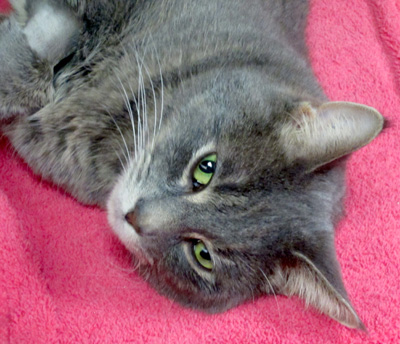 November 2011
November 2011
Cooper’s Dilemma
Hey all!  My name is Cooper and I am a beautiful gray kitty who lives a good life indoors.  My owners love me very much and life is generally pretty good, but a few weeks ago I started vomiting on a fairly regular basis – at least once a day.  I didn’t feel sick; I was still active and had a good appetite, but my owners were concerned and had also noticed that I wasn’t having as many bowel movements as normal.  After a few days of this, my owners brought me to another vet where they gave me fluids and said if my vomiting continued to bring me back.  Well I did continue to vomit and so my owners brought me here to the Dunkirk Animal Clinic for a second opinion.
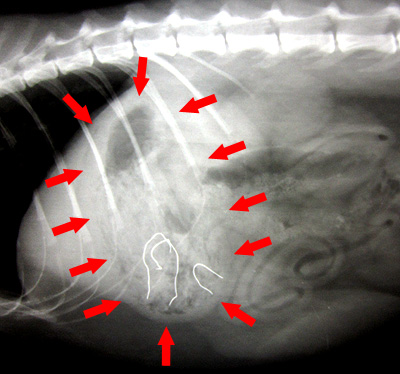 As the veterinarian was feeling my stomach, she noticed a hard mass in my abdomen – definitely NOT normal.  It was immediately decided that I should stay in the hospital and that an x-ray be taken.  The x-ray revealed a large, indistinguishable mass in my stomach with two suspicious strands of what appeared to be wire.  While all of my vitals were normal, I was kept overnight to recheck the x-ray in the morning and see if whatever was in my stomach had moved.  The next day, both the mass and wire strands had not budged.  At this point, realizing the mass was not ever likely to pass through or resolve on its own, the doctor recommended an exploratory surgery to remove it.  My owners gave the OK to go to surgery first thing Monday morning.  In the meantime, I was kept on IV fluids for hydration and given antibiotics.
As the veterinarian was feeling my stomach, she noticed a hard mass in my abdomen – definitely NOT normal.  It was immediately decided that I should stay in the hospital and that an x-ray be taken.  The x-ray revealed a large, indistinguishable mass in my stomach with two suspicious strands of what appeared to be wire.  While all of my vitals were normal, I was kept overnight to recheck the x-ray in the morning and see if whatever was in my stomach had moved.  The next day, both the mass and wire strands had not budged.  At this point, realizing the mass was not ever likely to pass through or resolve on its own, the doctor recommended an exploratory surgery to remove it.  My owners gave the OK to go to surgery first thing Monday morning.  In the meantime, I was kept on IV fluids for hydration and given antibiotics.
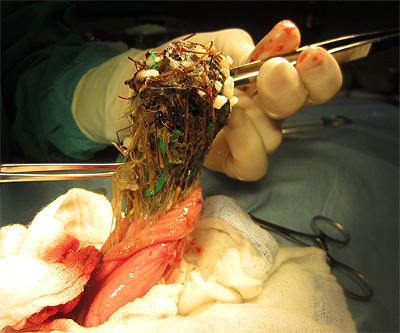 The “indistinguishable” mass was removed from my stomach and it was made up of all sorts of fun string-like objects: dried sticks from a wreath, grass, ribbon, Easter grass, and wire! The next day after one more night in the hospital for monitoring, I was released to my very happy owners. My owners were told to hide and remove anything “string-like” being that I have such an affinity for strings! Ten days later I came in for my stitch removal – everything had healed well and I was no longer vomiting. I was a new cat!  Hopefully in the future however, I’ll be a little more careful about my dietary indiscretions.
The “indistinguishable” mass was removed from my stomach and it was made up of all sorts of fun string-like objects: dried sticks from a wreath, grass, ribbon, Easter grass, and wire! The next day after one more night in the hospital for monitoring, I was released to my very happy owners. My owners were told to hide and remove anything “string-like” being that I have such an affinity for strings! Ten days later I came in for my stitch removal – everything had healed well and I was no longer vomiting. I was a new cat!  Hopefully in the future however, I’ll be a little more careful about my dietary indiscretions.
October 2011
Frank and The Diarrhea Diaries
Hi, I’m Frank the West Highland Terrier and I have a condition called Exocrine Pancreatic Insufficiency or EPI. My pancreas is unable to make enough of the enzymes necessary to digest my food.  Because of this, I have diarrhea, gas, strange colored or greasy bowel movements, weight loss and occasional vomiting and I am hungry ALL the time.  Without these enzymes my body is not able to break down and utilize all the nutrients in my food and my body begins to waste away.  If I’m not treated, EPI can affect my entire body, including my nervous and immune systems.  This is NOT a fun condition and it is often difficult to diagnose because these symptoms can be indicative of SO many other diseases.  Fortunately for me though, I was diagnosed, am receiving treatment, and am now leading a very normal, healthy life.  Here is my journey.
In January of this year, I started passing bowel movements (BM) with a lot of blood and mucus.  I was also beginning to lose weight, which was odd because I was a young, active, very happy and curious dog.  My owners brought me into the vet’s office where they tested a fecal sample to look for internal parasites (a very common cause of diarrhea).  Nothing showed under the microscope (also common), but the vet sent me home with a good de-wormer and medicine for a possible bowel infection.  Over the next few weeks, I did much better – my BM was normal with no blood.
All seemed to be going well until mid-April when I again presented with very loose, bloody stools.  The vet’s office ran another fecal sample and again, no parasites were seen.  At this time, I was diagnosed with Stress Colitis and given a different anti-diarrhea medicine.  My BM improved a little bit and I was also given more of an antibiotic for any infection of the bowels.
In mid July, my owners were going out of town so I was boarded at my Vet’s clinic.  Over this time, my BM was extremely loose again with blood and mucus.  I was treated and put on a special diet for a possible food allergy.
In mid-August, my condition was such that I was hospitalized overnight and kept on fluids.  In the morning Dr Frost took some blood and sent it out to a laboratory for a test called Tripsin-Like Immunoreactivity (TLI), to check out my pancreas levels.  This test showed my pancreatic enzymes were VERY low and that I appeared to be losing protein through my GI tract.  Neither of these were good findings, however a diagnosis was made – Exocrine Pancreatic Insufficiency!  That same day I was put on Pancreazyme, a supplement for the pancreas and started on a different special diet for GI health.  The results were nearly immediate!  My bowel movements became normal, I gained weight and I felt like a million dog bones!  To this day, I am a healthy, happy dog.  I’ll always be on pancreas support and need a special diet, but there is no reason I won’t live many, many more fine doggie years.
September 2011
Introducing “Ashes”
Hi, my name is Ashes and I am one very lucky cat! About a month ago I was in a mobile home fire where several of my feline and canine friends were not so lucky.  I don’t remember a whole lot – everything was very hot and very smoky and very loud. I struggled for several days under the rubble of the burned home until at last I squirmed my way out from the ashes and a kind passerby found me. My beautiful whiskers were singed near to nothing and the tips of my ears and tail were burned off. I had huge scabs from the hot fire all over my body, and three of my little paws were nearly unrecognizable they were so badly burned.
I was also extremely thin and blood tests showed that I was severely anemic – so much so, that Mystery, the clinic cat, was kind enough to donate blood for a transfusion.  After the fire, I was in a great deal of pain but somehow still had a voracious appetite and a great attitude. By chance and a little luck, I ended up at the Dunkirk Animal Clinic where for the last several weeks they have been taking great care of me.
Every day, they have cleaned my paws, changed my bandages, fed me ‘gourmet’ meals and given me medicine to stop infection. Though it will be awhile before I am fully healed, I am doing MUCH better and absolutely LOVE all the attention I am getting. I could not be any happier a cat.
August 2011
“Doc” Schroeter
Hi, my name is Doc, and I am very fortunate to have been found in a ditch by two very loving strangers.  When they found me I was only two pounds and I was very sick. I was severely congested, dehydrated and I had a runny nose and eyes. Worst of all I couldn’t use my left hind leg at all and my face badly injured. I don’t remember how this happened but I am pretty sure that I had a bad run-in with a car.
My new owners took me to see Dr. Frost, and after her exam she recommended that I have multiple tests and diagnostics to determine everything that was wrong with me. Thankfully my owners agreed.
I was negative for Feline Leukemia, FIV and Feline Heartworms, but I did have ear mites, intestinal parasites, an infected broken leg and several lacerations on my face. Dr. Frost started me on ear mite treatment, an eye ointment, fluid therapy and antibiotics so I could start the healing process. The biggest decision my owners had to make involved my broken leg. My leg was badly broken and infected. Dr. Frost recommended that my leg be amputated. My owners agreed that this  would be the best thing for me for a long and healthy life.
It took me four days on medications, good nourishment and lots of tender care before I was ready for my amputation surgery. Dr. Carlson amputated my leg and sutured the lacerations on my face. I recovered nicely from my surgery and I spent one more night to sleep off my anesthesia before going to my new home.  Two weeks after my surgery I had my stitches taken out, was vaccinated and gained a whole pound. Once I was home I was so happy! I just wanted to eat as much as I could and you would never know that I had only three legs. I was running around and playing with my fellow cat-mates!
I am so thankful for everyone’s hard work and efforts. I am especially so thankful to my new owners who pulled me out of the ditch and gave me an enormous amount of love and care!

